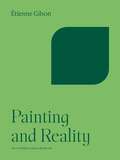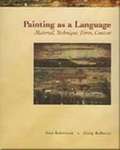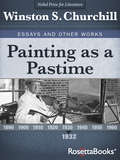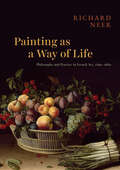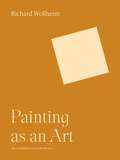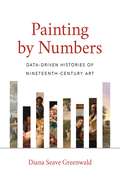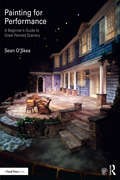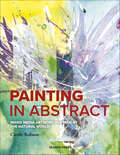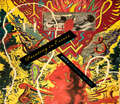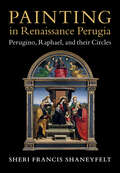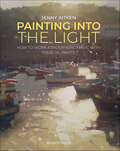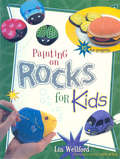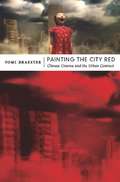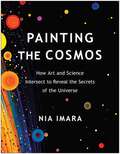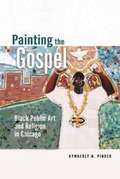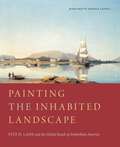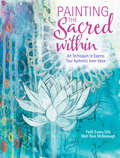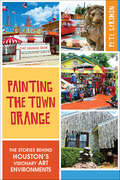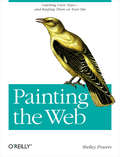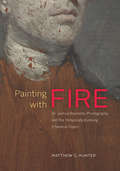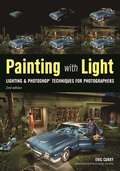- Table View
- List View
Painting and Reality (The A. W. Mellon Lectures in the Fine Arts #4)
by Etienne GilsonA classic study of the art of painting and its relationship to reality In this book, Étienne Gilson puts forward a bold interpretation of the kind of reality depicted in paintings and its relation to the natural order. Drawing on insights from the writings of great painters—from Leonardo, Reynolds, and Constable to Mondrian and Klee—Gilson shows how painting is foreign to the order of language and knowledge. Painting, he argues, seeks to add new beings to nature, not to represent those that already exist. For this reason, we must distinguish it from another art, that of picturing, which seeks to produce images of actual or possible beings. Though pictures play an important part in human life, they do not belong in the art of painting. Through this distinction, Gilson sheds new light on the evolution of modern painting. A magisterial work of scholarship by an acclaimed historian of philosophy, Painting and Reality features paintings from both classical and modern schools, and includes extended selections from the writings of Reynolds, Delacroix, Gris, Gill, and Ozenfant.
Painting as a Language: Material, Technique, Form, Content
by Jean Robertson Craig McdanielDesigned to address the issues of how to paint and what to paint, PAINTING AS A LANGUAGE covers a wide range of information of central importance to beginning and intermediate painting instruction. The authors emphasize the value of the student's cognitive understanding of the process and potential of painting in the student's overall progress in the studio. Blending journal writing with painting and drawing exercises, they guide the student through selecting meaningful subject matter as well as becoming adept at shaping and interpreting that material through the language of painting.
Painting as a Pastime (Winston S. Churchill Essays and Other Works #1)
by Winston S. ChurchillThe first volume in a collection essays and journalism from the legendary politician and Nobel Prize–winning author explores his artistic pursuits. Legendary politician and military strategist Winston S. Churchill was a master not only of the battlefield, but of the page and the podium. Over the course of forty books and countless speeches, broadcasts, news items and more, he addressed a country at war and at peace, thrilling with victory but uneasy with its shifting role on the global stage. In 1953, he was awarded the Nobel Prize for Literature for &“his mastery of historical and biographical description as well as for brilliant oratory in defending exalted human values.&” During his lifetime, he enthralled readers and brought crowds roaring to their feet; in the years since his death, his skilled writing has inspired generations of eager history buffs. Best known for his political genius and keen eye for military tactics, Churchill was a man of many talents—not the least of which was painting. Throughout his life, Churchill painted to relieve his mind from the demands of leadership and to keep the &“black dog&” of depression at bay. Included in this volume are Churchill&’s meditations on painting as a salve for the spirit and an essential creative pursuit. His love for the craft comes to life in this concise yet impassioned work. This volume includes eighteen reprints of Churchill&’s original work in oil, giving the reader a window into the little-known creative and artistic skill of this prominent figure in twentieth century history.
Painting as a Way of Life: Philosophy and Practice in French Art, 1620–1660
by Richard NeerNeer uncovers a key moment in the history of early modern art, when painting was understood to be a tool for self-transformation and for living a philosophical life. In this wide-ranging study, Richard Neer shows how French painters of the seventeenth century developed radically new ways to connect art, perception, and ethics. Cutting across traditional boundaries of classicism and realism, Neer addresses four case studies: Nicolas Poussin, renowned for marrying ancient philosophy and narrative painting; Louise Moillon, who pioneered French still life in the 1630s; Georges de La Tour, a painter of intense and introspective nocturnes; and the Brothers Le Nain, specialists in genre and portraiture who inspired Courbet, Manet, and other painters of modern life. Setting these artists in dialogue with Montaigne, Descartes, Pascal, and others, ranging from the studios of Rome to the streets of Paris, this book provides fresh accounts of essential artworks—some well-known, others neglected—and new ways to approach the relation of art, theory, and daily life.
Painting as an Art (The A. W. Mellon Lectures in the Fine Arts #33)
by Richard WollheimOne of the twentieth century’s most influential texts on philosophical aestheticsPainting as an Art is acclaimed philosopher Richard Wollheim’s encompassing vision of how to view art. Transcending the traditional boundaries of art history, Wollheim draws on his three great passions—philosophy, psychology, and art—to present an illuminating theory of the very experience of art. He shows how to unlock the meaning of a painting by retrieving—almost reenacting—the creative activity that produced it. In order to fully appreciate a work of art, Wollheim argues, critics must bring a much richer conception of human psychology than they have in the past. This classic book points the way to discovering what is most profound and subtle about paintings by major artists such as Titian, Bellini, and de Kooning.
Painting by Numbers: Data-Driven Histories of Nineteenth-Century Art
by Diana Seave GreenwaldA pathbreaking history of art that uses digital research and economic tools to reveal enduring inequities in the formation of the art historical canonPainting by Numbers presents a groundbreaking blend of art historical and social scientific methods to chart, for the first time, the sheer scale of nineteenth-century artistic production. With new quantitative evidence for more than five hundred thousand works of art, Diana Seave Greenwald provides fresh insights into the nineteenth century, and the extent to which art historians have focused on a limited—and potentially biased—sample of artwork from that time. She addresses long-standing questions about the effects of industrialization, gender, and empire on the art world, and she models more expansive approaches for studying art history in the age of the digital humanities.Examining art in France, the United States, and the United Kingdom, Greenwald features datasets created from indices and exhibition catalogs that—to date—have been used primarily as finding aids. From this body of information, she reveals the importance of access to the countryside for painters showing images of nature at the Paris Salon, the ways in which time-consuming domestic responsibilities pushed women artists in the United States to work in lower-prestige genres, and how images of empire were largely absent from the walls of London’s Royal Academy at the height of British imperial power. Ultimately, Greenwald considers how many works may have been excluded from art historical inquiry and shows how data can help reintegrate them into the history of art, even after such pieces have disappeared or faded into obscurity.Upending traditional perspectives on the art historical canon, Painting by Numbers offers an innovative look at the nineteenth-century art world and its legacy.
Painting for Performance: A Beginner’s Guide to Great Painted Scenery
by Sean O'SkeaPainting for Performance removes the mystery from painting and gives beginners the terms, tools, and techniques to approach their unpainted set with confidence. Covering the mechanics of paint and its many implementations in set design, this book provides simple and effective step-by-step instructions for painting a variety of surfaces to look great on stage.
Painting in Abstract: Mixed Media Artwork Inspired by the Natural World
by Carole RobsonLearn to capture the abstract beauty of the natural world in paint and mixed media with this inspiring book.A practical, mixed media art book, illustrated with finished paintings and short exercises that encourage an experimental approach to painting the natural landscape.Carole Robson's aim is to inspire readers with her own enthusiasm for art and, as a teacher, to help them to achieve their own artistic goals. Her work is a celebration of the natural landscape, and her intention is always to shine a light on nature in order to elevate its case, especially poignant now that nature is in such jeopardy.This book guides the reader through simple combinations of wet media such as watercolour, gouache, acrylic and Indian inks. It goes on to examine and include other media and techniques; exploring media that combine happily, and those that resist each other to create interesting and unexpected effects.It offers strategies for developing concepts and improving design, with a chapter devoted to the formal elements – line, shape, colour, tone, texture and surface pattern – that can be harnessed to produce impactful work. Readers will be provided the tools and inspiration to find their own interpretations.Carole covers various aspects of the natural landscape, from close-up details to more distant views, celebrating wild flowers, seed heads, berries and leaves. It peers inquisitively into ditches, hedgerows and verges, and soaks up the idyll of flower-rich meadows. It will visit the tranquility of woodland scenes as well as the atmospheric, wild elements of stormy skies and high seas.Exciting techniques such as washing or spraying off an image, using improvised mark-making tools, preparing a variety of collage papers such as painting through tissue paper are included; alongside printing or stencilling acrylic gel or texture paste to enliven a surface.This book offers a unique route into creativity and innovation for the reader, whether beginner or expert artist.
Painting in Excess: Kyiv's Art Revival, 1985-1993
by Olena MartynyukThe upheavals of glasnost and perestroika followed by the collapse of the Soviet Union remarkably transformed the art scene in Kyiv, launching Ukrainian contemporary art as a global phenomenon. The previously calm waters of the culturally provincial capital of the Ukrainian Soviet Republic became radically stirred with new and daring art made publicly visible for the first time since the avant-garde period of the early twentieth century. As artists were freed from the dictates of the fading Communist ideology and the constraints of late socialist realism, an explosion of styles emerged, creating an effect of baroque excess. This exhibition catalogue traces and documents the diverse artistic manifestations of these transitional and exhilarating years in Kyiv while providing some historical artworks for context. Published in partnership with the Zimmerli Museum.
Painting in Renaissance Perugia: Perugino, Raphael, and their Circles
by Sheri Francis ShaneyfeltThis volume offers the first comprehensive study of painting in Renaissance Perugia from the late fifteenth to the mid- sixteenth centuries. Showcasing works by Perugino, Raphael, and Pintoricchio, as well as less familiar artists who worked in Perugia from ca. 1480–1540, Sheri Shaneyfelt traces the influence and impact of Perugino's workshop in central Italy over more than a half a century. She demonstrates why Perugia, which has been overlooked in modern scholarship, was such a vital center for the production of early modern Italian art. Shaneyfelt's study also shifts the focus away from the analysis of individual artistic creativity by highlighting the importance and significance of collaboration and workshop production in Renaissance Italy. Interweaving historical and archival evidence with analyses of numerous paintings and drawings, her book, richly illustrated with 115 color illustrations, offers many new insights into the vibrant artistic culture of early modern Perugia.
Painting into the Light: How to Work Atmospheric Magic with Your Oil Paints
by Jenny AitkenReknowned for her techniques for painting light on water, Jenny Aitken delivers perfect guidance to the intermediate artist on how to paint light in plein air and much more.Learn how to successfully paint scenes that that capture magical effects of light from behind the subject. Good contre-jour – painting into the light – artworks cause the viewer to squint, with light seeming to glow from the canvas. They can look like a kind of magic, with their hazy light and colour singing out. This book demystifies lighting in oils, and provides a practical guide to the process, showing exactly how to create the illusion.Inside, you'll find a wealth of information on simplification, tonal control, capturing accurate colour, working both indoors and outdoors, painting landscapes and still life, creating atmospheric depth, and even mastering the illusion of space. Through detailed step-by-step demonstrations and beautifully illustrated techniques, Jenny Aitken reveals how to infuse every painting with vibrant, lifelike light. A section on troubleshooting tricky paintings will show the reader every painting is salvageable, but with an understanding of light and colour, it’s much more likely that they’ll find success the first time round.
Painting on Rocks for Kids
by Lin WellfordHey kids! You can create amazing creatures, incredible toys and wild gifts for your friends and family. All it takes is some paint, a few rocks and your imagination!Decorate your room. Make doorstops or bookends. Or just paint something for fun. Easy-to-follow pictures and instructions show you how to create:Rockasaurus! (Who wouldn't want a dinosaur for a pet?)Stone buildings perfect for creating your very own cityRockburgers and other fun foods--you wouldn't want to eat these, but they sure look tastyCootie bugs and racecars (Which one is faster? You decide!)Realistic lizards ready to put in your family's garden (gasp!) or the terrarium in your roomFlowers that never wilt--and never have to be wateredWeird eggs! (Could be aliens, could be dragons--who knows? Hatch them and find out.)Teddy bears cute enough to cuddle!You'll learn how to draw each design on a rock with a pencil, then paint the details in whatever colors you choose. You can make each project look just like the real thing or wild or wacky. The choice is yours--and so is the fun!
Painting the City Red: Chinese Cinema and the Urban Contract
by Yomi BraesterPainting the City Red illuminates the dynamic relationship between the visual media, particularly film and theater, and the planning and development of cities in China and Taiwan, from the emergence of the People's Republic in 1949 to the staging of the Beijing Olympics in 2008. Yomi Braester argues that the transformation of Chinese cities in recent decades is a result not only of China's abandonment of Maoist economic planning in favor of capitalist globalization but also of a shift in visual practices. Rather than simply reflect urban culture, movies and stage dramas have facilitated the development of new perceptions of space and time, representing the future city variously as an ideal socialist city, a metropolis integrated into the global economy, and a site for preserving cultural heritage. Drawing on extensive archival research, interviews with leading filmmakers and urban planners, and close readings of scripts and images, Braester describes how films and stage plays have promoted and opposed official urban plans and policies as they have addressed issues such as demolition-and-relocation plans, the preservation of vernacular architecture, and the global real estate market. He shows how the cinematic rewriting of historical narratives has accompanied the spatial reorganization of specific urban sites, including Nanjing Road in Shanghai; veterans' villages in Taipei; and Tiananmen Square, centuries-old courtyards, and postmodern architectural landmarks in Beijing. In Painting the City Red, Braester reveals the role that film and theater have played in mediating state power, cultural norms, and the struggle for civil society in Chinese cities.
Painting the Cosmos: How Art and Science Intersect to Reveal the Secrets of the Universe
by Nia ImaraA stunning portrait of our vast, dynamic, and mysterious universe . . . as seen through the lenses of astronomy and artWhat is our place in the universe? Where do art and science overlap? How can we use these disciplines to better understand the universe . . . and how do they help us to shape our reality? In Painting the Cosmos, astrophysicist and visual artist Nia Imara combines these perspectives to comprehensively illustrate the history of the universe and our position in it. In this eye-opening and accessible book, Imara asks pivotal questions and explores humanity&’s ever-evolving view of nature. Richly illustrated with spectacular full-color images of our universe and beautiful work from creators around the world—particularly the often-neglected work of women and Black artists—this one-of-a-kind book unites the realms of art, science, and culture to create a dynamic portrait of the cosmos. From the Big Bang to life on other planets—while also explaining the most exciting recent developments in astronomy—with Imara&’s guiding expertise, readers will explore: The limits of objectivity in understanding reality The role of harmony and rhythm in the universe and art How light functions as a storyteller How scientists and artists help us &“see&” the invisible—from black holes to marginalized experiences The possibility of life beyond our solar system, and how we define intelligence Painting the Cosmos will captivate and inspire you to see the world around you in a brand new, fascinating light where space and art are beautifully intertwined.
Painting the Gospel: Black Public Art and Religion in Chicago (The New Black Studies Series)
by Kymberly N PinderInnovative and lavishly illustrated, Painting the Gospel offers an indispensable contribution to conversations about African American art, theology, politics, and identity in Chicago. Kymberly N. Pinder escorts readers on an eye-opening odyssey to the murals, stained glass, and sculptures dotting the city's African American churches and neighborhoods. Moving from Chicago's oldest black Christ figure to contemporary religious street art, Pinder explores ideas like blackness in public, art for black communities, and the relationship of Afrocentric art to Black Liberation Theology. She also focuses attention on art excluded from scholarship due to racial or religious particularity. Throughout, she reflects on the myriad ways private black identities assert public and political goals through imagery. Painting the Gospel includes maps and tour itineraries that allow readers to make conceptual, historical, and geographical connections among the works.
Painting the Inhabited Landscape: Fitz H. Lane and the Global Reach of Antebellum America
by Margaretta M. LovellThe impulse in much nineteenth-century American painting and culture was to describe nature as a wilderness on which the young nation might freely inscribe its future: the United States as a virgin land, that is, unploughed, unfenced, and unpainted. Insofar as it exhibited evidence of a past, its traces pointed to a geologic or cosmic past, not a human one. The work of the New England artist Fitz H. Lane, however, was decidedly different.In this important study, Margaretta Markle Lovell singles out the more modestly scaled, explicitly inhabited landscapes of Fitz H. Lane and investigates the patrons who supported his career, with an eye to understanding how New Englanders thought about their land, their economy, their history, and their links with widely disparate global communities. Lane’s works depict nature as productive and allied in partnership with humans to create a sustainable, balanced political economy. What emerges from this close look at Lane’s New England is a picture not of a “virgin wilderness” but of a land deeply resonant with its former uses—and a human history that incorporates, rather than excludes, Native Americans as shapers of land and as agents in that history.Calling attention to unexplored dimensions of nineteenth-century painting, Painting the Inhabited Landscape is a major intervention in the scholarship on American art of the period, examining how that body of work commented on American culture and informs our understanding of canon formation.
Painting the Sacred Within: Art Techniques to Express Your Authentic Inner Voice
by Faith Evans-Sills Mati McdonoughClaim your space. Start painting. Begin now. By Painting the Sacred Within you, you'll unlock a new rhythm of working intuitively to allow space for your own transformation. Inside these pages, you'll discover twelve areas of focus as you learn to see your world through paint and to experience deeper self-exploration. You will learn new ways of seeing, how to experiment with abstract techniques, how to work with natural elements, how to meditate with mandalas and much, much more.Experiment with freeing and engaging techniques such as pouring paint, lettering with a brush and painting on unconventional surfaces.Uncover the continuous thread that runs through your work as you develop art-making rituals and learn the importance of investing time in your creative dreams as you develop healthy studio habits.In addition to more than 14 step-by-step demonstrations, you'll discover inspiring works from guest artists, learn helpful tips on self-care and find a plethora ideas for making creativity a part of your lifestyle.Begin a new practice today. Let Painting the Sacred Within ignite the creative spark inside you.
Painting the Town Orange: The Stories behind Houston's Visionary Art Environments (Landmarks)
by Pete GershonHouston's sprawl has come with controversy, but it has created a blank canvas for the public art community. It all started in the Telephone Road Place subdivision, where retired mail carrier Jefferson Davis McKissack built the Orange Show, an extraordinary and eccentric monument to self-reliance, hard work and, yes, the fruit itself. McKissack's installation spawned more of its kind in the Bayou City, like the Beer Can House, the Flower Man's House, Pigdom--one woman's "shrine to swine"--and a flourishing art scene committed to preserving Houston's art environments. Author Pete Gershon tells the stories of these sites, their creators and the members of Houston's unique art community, all set against the backdrop of the city's quirky history..
Painting the Wall (Fountas & Pinnell Classroom, Guided Reading Kindergarten)
by David Dean Jennifer CareyNIMAC-sourced textbook
Painting the Web: Catching the User's Eyes - and Keeping Them on Your Site
by Shelley PowersDo you think that only professionals with expensive tools and years of experience can work with web graphics? This guide tosses that notion into the trash bin.Painting the Web is the first comprehensive book on web graphics to come along in years, and author Shelley Powers demonstrates how readers of any level can take advantage of the graphics and animation capabilities built into today's powerful browsers. She covers GIFs, JPEGs, and PNGs, raster and vector graphics, CSS, Ajax effects, the canvas objects, SVG, geographical applications, and more -- everything that designers (and non-designers) use to literally paint the Web. More importantly, Shelley's own love of web graphics shines through in every example. Not only can you master the many different techniques, you also can have fun doing it. Topics in Painting the Web include:GIF, JPEG, PNG, lossy versus lossless compression, color management, and optimization Photo workflow, from camera to web page, including a review of photo editors, workflow tools, and RAW photo utilities Tricks for best displaying your photos online Non-photographic raster images (icons and logos), with step-by-step tutorials for creating popular "Web 2.0" effects like reflection, shiny buttons, inlays, and shadows Vector graphics An SVG tutorial, with examples of all the major components Tips and tricks for using CSS Interactive effects with Ajax such as accordions and fades The canvas object implemented in most browsers Geographical applications such as Google Maps and Yahoo Maps, with programming and non-programming examples Visual effects such as forms and data displays in table or graphics Web design for the non-designer Graphics are not essential to the web experience, but they do make the difference between a site that's functional and one that's lively, compelling, and exciting. Whether you want to spruce up a website, use photos to annotate your stories, create hot graphics, or provide compelling displays for your data, this is the book for you.
Painting with Brusho: Create Vibrant & Expressive Paintings Using Watercolour Ink Powder
by Joanne Boon ThomasBrusho – a highly pigmented watercolour ink powder – is a unique and exciting painting medium that is renowned for its versatility.Joanne Boon Thomas demonstrates how adding a spritz of water to Brusho results in a breathtaking and spontaneous fusion of colour on the page. It is an easy method that allows you to produce vibrant, expressive paintings in a loose, bold style.A full range of techniques is included, such as what can be achieved using only one colour; how effective blending primary colours is; and the hidden qualities of black Brusho. Short demos show the impact of using a bleach solution; how to use wax resist for effect; when to use a flat wash; and how to use line and wash as a loose framework for your paintings. Ten step-by-step projects and numerous examples of the author’s stunning work will inspire, all infused throughout with Joanne’s exuberance and enthusiasm for this wonderful medium.This definitive go-to guide will inspire artists of all abilities to explore the improvisational properties of Brusho and incorporate it into their painting repertoire.
Painting with Fire: Sir Joshua Reynolds, Photography, and the Temporally Evolving Chemical Object
by Matthew C. HunterPainting with Fire shows how experiments with chemicals known to change visibly over the course of time transformed British pictorial arts of the long eighteenth century—and how they can alter our conceptions of photography today. As early as the 1670s, experimental philosophers at the Royal Society of London had studied the visual effects of dynamic combustibles. By the 1770s, chemical volatility became central to the ambitious paintings of Sir Joshua Reynolds, premier portraitist and first president of Britain’s Royal Academy of Arts. Valued by some critics for changing in time (and thus, for prompting intellectual reflection on the nature of time), Reynolds’s unstable chemistry also prompted new techniques of chemical replication among Matthew Boulton, James Watt, and other leading industrialists. In turn, those replicas of chemically decaying academic paintings were rediscovered in the mid-nineteenth century and claimed as origin points in the history of photography. Tracing the long arc of chemically produced and reproduced art from the 1670s through the 1860s, the book reconsiders early photography by situating it in relationship to Reynolds’s replicated paintings and the literal engines of British industry. By following the chemicals, Painting with Fire remaps familiar stories about academic painting and pictorial experiment amid the industrialization of chemical knowledge.
Painting with Light
by Eric CurryThrow your preconceptions about light-painting out the window and prepare for a creative journey that will revolutionize your photography. Light painting is a classic photography technique that involves selectively illuminating sections of a dark subject by moving a light source (like a flashlight) over the subject during the course of a seconds- or minutes-long exposure. This results in uniquely nuanced depictions with a high level of technical artistry. As Eric Curry shows, however, today’s hardware and software allow you to produce light-painting images that are anything but traditional! In this book, you’ll learn, step by step, how to plan and execute incredible, nuanced images using simple gear, a whole lot of imagination, and today’s powerful postproduction software. With these techniques, your imagination is the only limit to what you can create!
Painting with Light
by Janleonardo Woellert Joerg MiedzaLight Art Performance Photography (LAPP) is a unique form of art that was invented and developed by the authors of this book. It is one of the first forms of art using light as the medium to gain widespread attention. Unlike other types of light painting, LAPP does not just involve illuminating existing objects; it also requires the photographer to create and capture new subjects constructed entirely of light. LAPP pieces are usually shot at night using long exposure times to capture complex sequences of precisely choreographed movements. Real-world surroundings are combined with transient, light-based elements to produce spectacular effects. The defining characteristic of LAPP is the harmony between the background and the harsh light often used to produce the individual image elements. The symbiosis between photographer and performer gives each work a degree of reproducibility that is essential if it is to be accurately restaged at a later time. The first part of this book describes the evolution of LAPP as told by its originators, while the middle section goes on to present a gallery of spectacular, large format LAPP images. The final section offers some basic steps and tips to give you a starting point for creating your own LAPP artworks.
